The best sports cars – driven, rated and ranked
Here is the definitive top 10 list of the best sports cars currently on sale. Only one can be the very best…
News


by Jack Warrick and Matt Saunders
9 mins read
7 May 2025
Share
Sports cars are some of the most desirable vehicles a petrolhead can own.
First developed to bring some of the speed and excitement of early motorsport machines to the regular driver on the road, the sports car genre is almost as old as the car itself.
Nowadays, the best sports cars are more mature and can be driven every day. What’s best is there’s still a host of options on the market and the sports car is still going strong, despite the automotive industry’s gradual switch to electric-only power.
Related articles
- F1 involvement vital to growth of Alpine brand
- Alpine A290 hot hatch goes on sale in UK, priced from £33,500
- Electric 2026 Alpine A110 to be lighter than petrol rivals
- Alpine’s tri-motor tech to create ‘perceived lightness’ in heavy EVs
- Electric Alpine A110 won’t copy Hyundai Ioniq 5 N’s ‘fake’ engine
Several car makers – like BMW, Porsche, Mercedes-Benz and Alpine – are still heavily invested in the sports car world, using their expertise to produce some seriously capable models.
Thankfully, sports cars are still a traditional offering, with petrol power and high performance. Even as many other segments undergo rapid change, this one still deals with big power, lightweight engineering, high-revving combustion engines and outstanding handling dynamism.
But which sports cars are truly the best? We’ve listed our top picks in the full-sized sports car world right here, each with deep-chested acceleration and uplifting handling, and just as at home on the open road as they are on track.
We think the best sports car on sale today is the Alpine A110, but you will have to read on to find out why. Read on as we list the best sports cars still on sale in 2025.
1. Alpine A110
10
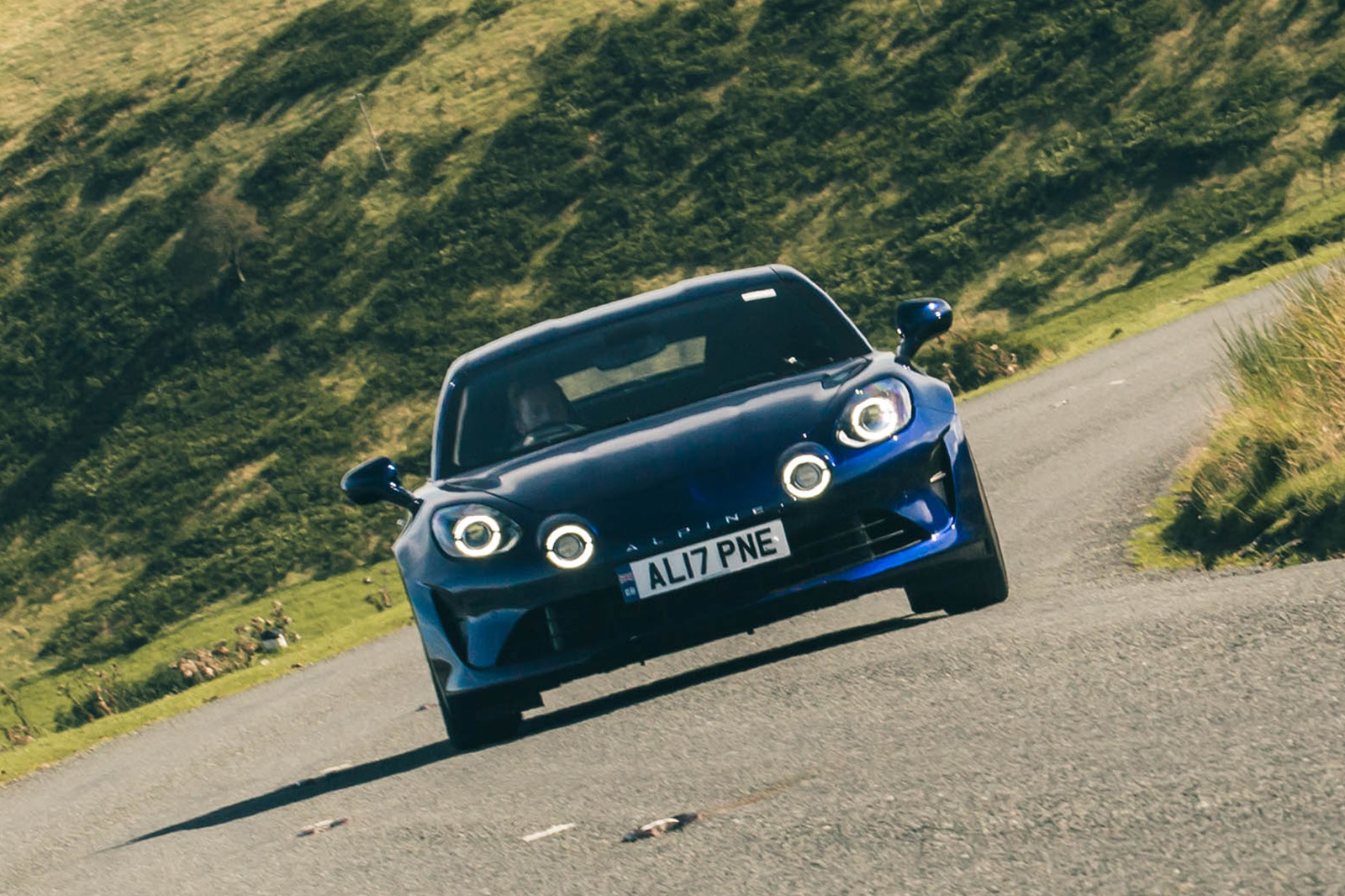
- Design9
- Interior7
- Performance9
- Ride & Handling10
- Costs9
Pros
Fantastic lightweight engineering
Remains usable and pleasant
Suspension overhaul hasn’t ruined the on-road ride
Cons
Engine only just does a passable job for the price
Chassis upgrades have taken some handling charm
Poor rear visibility
Best for: Handling
From its characterful turbocharged engine to its seriously impressive handling, the Alpine A110 is all about fun.
The A110 is quick, agile, effusive and ultimately enormous, accessible fun. It deserves the full five stars.
On paper, the A110 has all of the characteristics to mould the ideal all-round sports car. It features a lightweight aluminium body, a mid-mounted engine and double-wishbone suspension, mostly reserved for the most powerful supercars.
The A110 arrived in 2017 with 248bhp, followed by the A110 S with 288bhp, larger brakes and firmer suspension. Several special editions later, such as the Légende GT, the range is now topped by the hardcore A110 R Ultime.
We think the standard A110 is the pick of the lot, though, devoted to sublime driver involvement, with excellent grip, body control and poise on the road.
It’s also reasonably priced too, costing just under £55,000 in entry-level form.
Read our Alpine A110 review
Save money on a new Alpine A110 with What Car?
Finance this car with Drivenfi
Latest Reviews

Mercedes-Benz E-Class
8

Skoda Fabia
9

Audi A3 Sportback
7

Mercedes-Benz EQS
8

KGM Musso
6
Read our review
Car review

Alpine A110
France’s revered sports car brand is back and chasing some heavyweight scalps
Back to top
2. Porsche 911
9

- Design9
- Interior8
- Performance9
- Ride & Handling9
- Costs9
Pros
Acceleration and response of new hybrid GTS power unit
Simple and functional interior even with digital instruments
Mind-bendingly fast
Cons
Weight of the electrification dampens handling on track
Road noise louder than in some rivals
Costs more than previous iterations
Best for: All-round ability
It’s fair to say that the Porsche 911 is the most versatile sports car on the planet. Hold your breath, as we have quite a few to get through.
Any new 911 is still brilliant, and following the ‘992.2’ range realignment, there’s a clear role for every version
The 911 comes in Carrera, Carrera T, Carrera S and Carrera GTS specifications, all powered by a 3.0-litre turbocharged flat-six engine with differing power outputs. It also comes as a coupé, a cloth-top Cabriolet and a folding fixed-head Targa.
You can choose between rear- or four-wheel drive and between an eight-speed dual-clutch PDK automatic or a seven-speed manual gearbox.
There are also the extra-rapid Turbo, Turbo S, GT3 and GT3 RS versions higher up, not to mention extra-special limited-run versions like the Dakar and S/T. There’s not much to dislike with any of them.
Porsche introduced hybrid power in 2024, as part of the ‘992.2’ mid-life facelift. Many were curious about how it would affect the way the 911 drives, but it’s still a terrific, refined daily driver, with outstanding driving dynamics.
For a car that remains without equal among direct contemporary rivals for usability, rounded sporting credibility and especially for the accessible, everyday-use, any-occasion brilliance of its driver appeal, the evergreen 911 stands head and shoulders above most of its peers.
Read our Porsche 911 review
Save money on a new Porsche 911 with What Car?
Finance this car with Drivenfi
3. Mazda MX-5
9
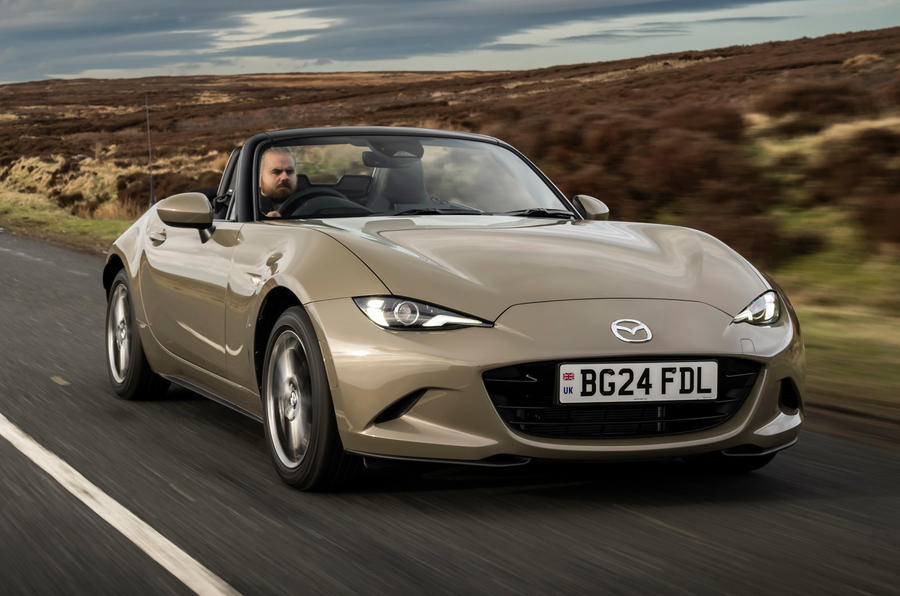
- Design10
- Interior8
- Performance9
- Ride & Handling9
- Costs8
Pros
Spirited performance
Balanced, involving handling
Excellent packaging
Cons
Not as quick as a like-for-like hot hatch
Overly light steering
Imperfect cabin ergonomics
Best for: Affordability
The fourth-generation Mazda MX-5 is shorter, lighter, more spacious and better laid out than any of its predecessors. Sharper-looking, too, but still disarming and not at all ostentatious. It’s also faster, more frugal and even more vibrant and engaging to drive.
There isn’t a single area in which this MX-5 fails to surpass its predecessor. It’s shorter, lighter, more spacious and better laid out.
In 2018, Mazda facelifted its iconic roadster, with the headline change being a 23bhp power hike for its feisty 2.0-litre engine. A steering column that also adjusts for reach was also introduced, addressing one of the MX-5’s only ergonomic drawbacks.
More minor tweaks have been executed since, the latest being for the 2023 model year. As part of it, Mazda UK changed the standard soft-top car’s model name convention from MX-5 Convertible to MX-5 Roadster; renamed its derivative trim levels (in place of SE-L, Sport and GT, now Prime, Exclusive and Homura); and added a Zircon Sand paint option.
Mechanically, no changes were made, so the 1.5-litre MX-5 still develops 130bhp, while the 2.0-litre model makes 181bhp but also gets a front strut brace, a limited-slip differential and uprated Bilstein dampers as standard.
Whichever you choose, rear-driven chassis poise and lots of driver involvement is guaranteed. That’s because the MX-5 is still every inch the same zesty and inimitable car that it always has been. Its character hasn’t really changed at all in three decades, and nothing on this list offers a better pounds-per-smile rating.
Read our Mazda MX-5 review
Save money on a new Mazda MX-5 with What Car?
Finance this car with Drivenfi
Back to top
4. BMW M2
9
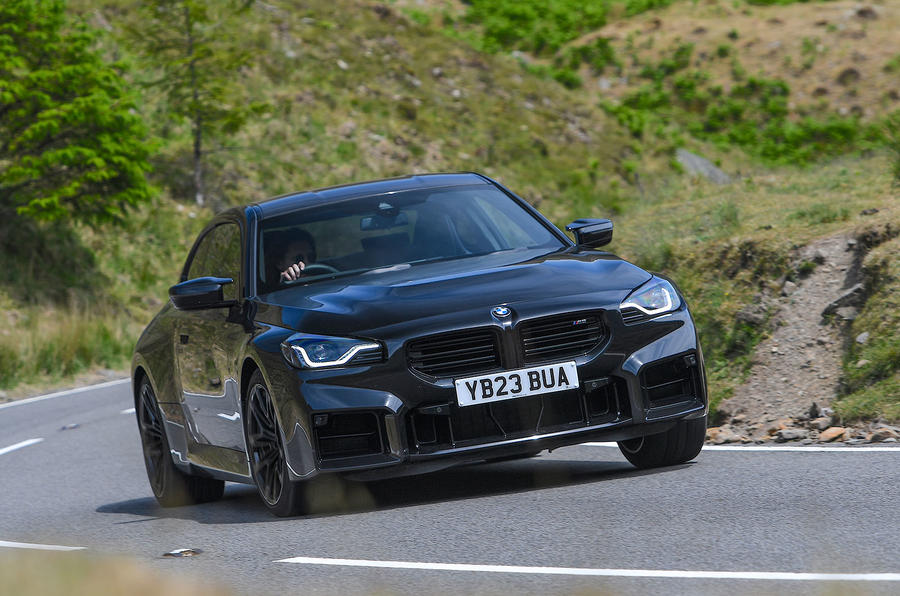
- Design8
- Interior8
- Performance9
- Ride & Handling9
- Costs8
Pros
‘S58’ engine has huge star quality, even in ‘detuned’ form
Engaging gearbox
Chassis combines nimbleness and comfort, unlike the previous M2
Cons
Extra size and weight is apparent in its handling
Subjective mutant hot-rod styling
Entry price has risen from £45k to £65k
Best for: Hardcore driving
When BMW’s M division decided to wrap M4 mechanicals in a shorter, slightly lighter shell and then retune what resulted to suit even keener enthusiast tastes, it hit on a winning recipe for the second-generation M2.
The M2 now feels like a much better whistle-wetter for everything BMW’s M division has become in 2023 and all that it offers. And, ironically enough, you might like it best because it also has a certain old-school charm.
The sense of technical inferiority that hung around previous iterations of this car was banished, and while the M2 grew (and grew heavier) as a result, it gained a sense of integrity, maturity and completeness as a modern M car that earns it a very high ranking in this chart.
The M2 now uses a slightly detuned version of the same ‘S58’ turbocharged straight-six that powers the M4 and has a healthy 453bhp to send straight to the rear-wheels. There’s also the option of a six-speed manual gearbox.
This car is a simpler, purer driver’s car than bigger M cars, and it retains just enough compactness to appeal in a way that the company’s bigger saloon and estate cars can’t.
It’s fast, balanced, involving and communicative yet also versatile, capable and very instantly driver-configurable, as characterises modern M cars so uniquely.
Read our BMW M2 review
Save money on a new BMW M2 with What Car?
Finance this car with Drivenfi
5. Porsche 718 Boxster/Cayman
9
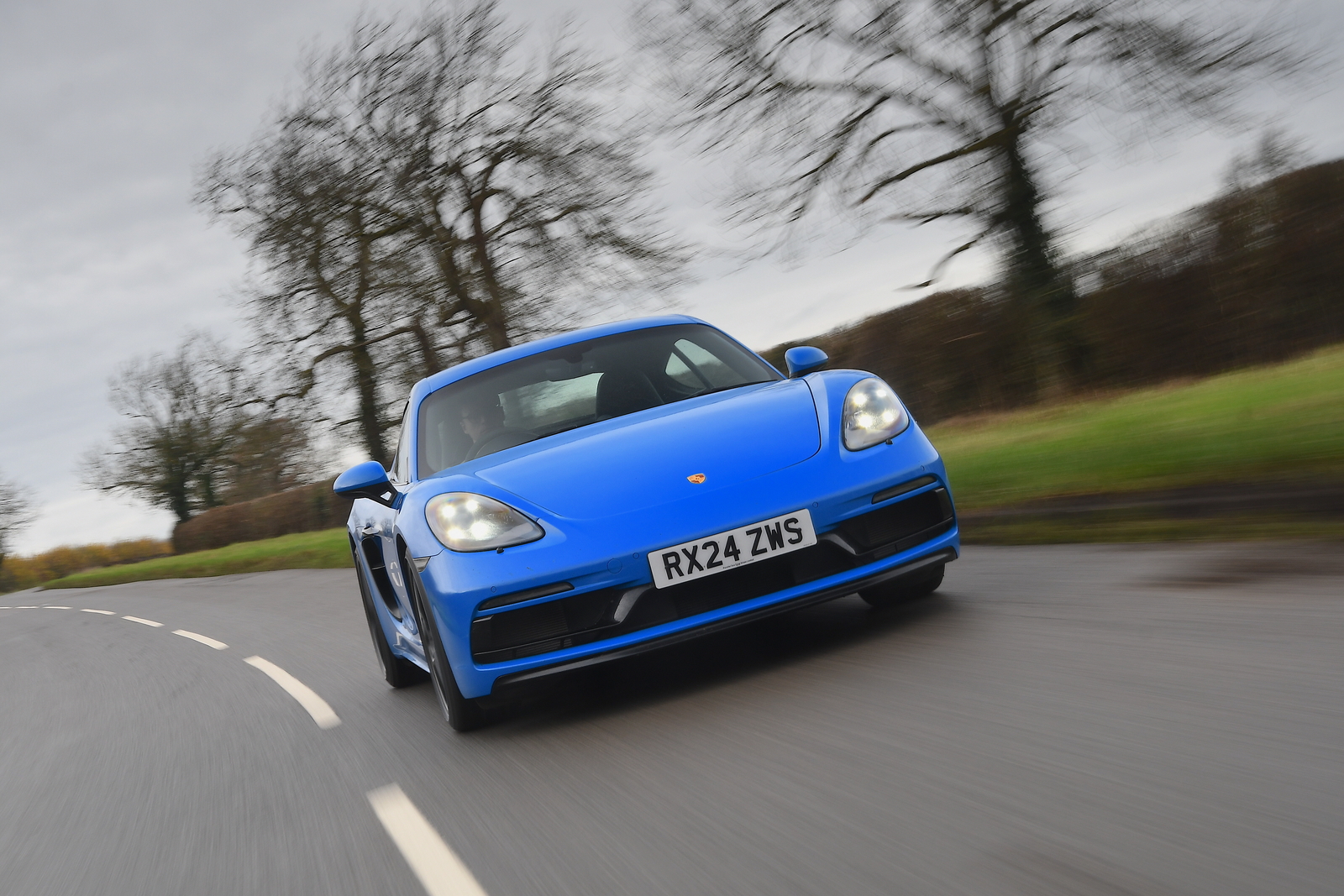
- Design9
- Interior8
- Performance9
- Ride & Handling9
- Costs9
Pros
Lots of speed
Synthesis of ride and handling
Tolerant stability control system
Cons
Other options here are more desirable
A fair bit of tyre roar
Four-cylinder engines are a bit gruff
Best for: Daily driving
Yes, there are two Porsches towards the top of this chart – and quite rightly so. The German firm really knows what it’s doing when it comes to screwing together a sensational sports car.
The 718 Cayman S is by some distance the most complete sports coupé on sale and easily talented enough in the handling department to overcome slight misgivings about the way the crank is now turned.
While the more affordable four-cylinder, sub-£50,000 derivatives of the 718 continue to present themselves to buyers with less to spend (and are ranked in our best affordable sports car top 10), the higher-end models have absolutely progressed among the bigger fish of the sports car class.
Not that they struggle in such treacherous water. Porsche’s latest naturally aspirated six-cylinder boxer engine is an utter joy, offering as much outright performance as any road-going sports car really needs but also wonderful smoothness and response and an 8000rpm operating range.
Unusually long-feeling gearing makes the six-speed manual versions slightly less appealing to drive in some ways than the seven-speed paddle-shift automatics, but for pure driver interaction, the three-pedal versions are hard to beat.
The 718’s beautifully poised handling, incredibly linear handling response and effortless body control at speed are now widely celebrated. This is the kind of sports car that can seem word-perfect in how it takes apart a cross-country road tough enough to expose a lesser machine.
If you like a sports car with more power than its chassis can easily deploy or whose dynamic quirks and flaws present something of a challenge to be ‘driven around’, you might even think a GTS 4.0 too good. Only kidding: it’s flippin’ brilliant.
Compared with some cars on this list, there’s also perhaps a slight lack of desirability for this car. But its usability is first-rate – and its powertrain can be considered every bit as stellar as its ride and handling. Quite simply, it’s one of the most complete driver’s cars there has ever been.
Read our Porsche 718 Boxster/Cayman review
Save money on a new Porsche 718 with What Car?
Finance this car with Drivenfi
Back to top
6. Aston Martin Vantage
9

- Design9
- Interior8
- Performance9
- Ride & Handling9
- Costs8
Pros
Bombastic power output and sound
Old-school front-engined rear-drive balance
Muscly, seductive appearance
Cons
Some turbo lag at low revs
Bigger than ever before
The Aston Martin Vantage is technically the brand’s entry-level model, but you wouldn’t think so when looking at its on-paper performance figures.
Powered by a sumptuous 4.0-litre, twin-turbocharged V8, the Vantage pumps out 656bhp and 590lb ft and will sprint from 0-62mph in just 3.4sec. It will also go on to a top speed of 202mph.
The Vantage has clearly moved up a step dynamically. It has more poise and predictability than before, meaning the excitement it delivers always comes on the terms of the driver.
The Vantage boasts a 50:50 weight distribution, which supports a seriously measured driving experience. Its handling inspires confidence, while ride comfort is unexpectedly good considering its performance pedigree.
Criticisms? Well, it’s the most expensive car on our list by some margin. Prices kick off from around £165,000, and that’s before you even add any options. Given the previous Vantrage cost around £40,000 less and many of their mechanical parts are shared, that’s not the easiest pill to swallow.
Read our Aston Martin Vantage review
Save money on a new Aston Martin with What Car?
Finance this car with Drivenfi
7. Lotus Emira
9

- Design8
- Interior9
- Performance9
- Ride & Handling9
- Costs6
Pros
Supremely poised chassis
Engaging steering
Class-leading driver involvement
Cons
Four-cylinder engine is a little unworthy
Isn’t as easy to live with as a Porsche
Unusual brake pedal feel
Best for: Driver involvement
As the last hurrah for combustion power at Lotus, the Emira certainly has a lot resting on its shoulders.
As a driver’s car, it’s mostly great. On challenging stretches of road is where it’s absolutely at its best, in fact.
And the good news is that the Norfolk newcomer gets so much right, from its junior exotic looks through to a chassis that maintains the decades-long tradition of Hethel handling greatness.
There are some novelties for a Lotus, too, such as an interior that delivers previously unheard of levels of luxury and quality, plus all the latest gadgets and gizmos.
It’s decently practical too, proving easier to get into and out of than the old Evora and packing handy storage. This is an everyday-usable sports car.
However, this extra usability and refinement comes at a cost, with the Emira weighing in at a very un-Lotus 1440kg, which is heavier even than the Porsche 718 Cayman GTS 4.0.
That means the supercharged Toyota 3.5-litre V6 doesn’t feel quite as strong as you would expect, its efforts aided and abetted by the slightly slack six-speed manual gearbox. That said, this is still a quick car, with the 0-62mph sprint taking 4.3sec.
More importantly, it drives like a Lotus where it matters: in the corners. The extra mass means it doesn’t feel quite as lithe as the old Elise, but the Emira is beautifully balanced and damped, helping it breathe with the surface where others attempt to pummel it into submission.
The steering is quick and feelsome, and as a result the Emira dives through bends with quick-witted agility, its ability to shrug off unsettling bumps further boosting your confidence.
Read our Lotus Emira review
Save money on a new Lotus Emira with What Car?
Finance this car with Drivenfi
Back to top
8. Ford Mustang
8
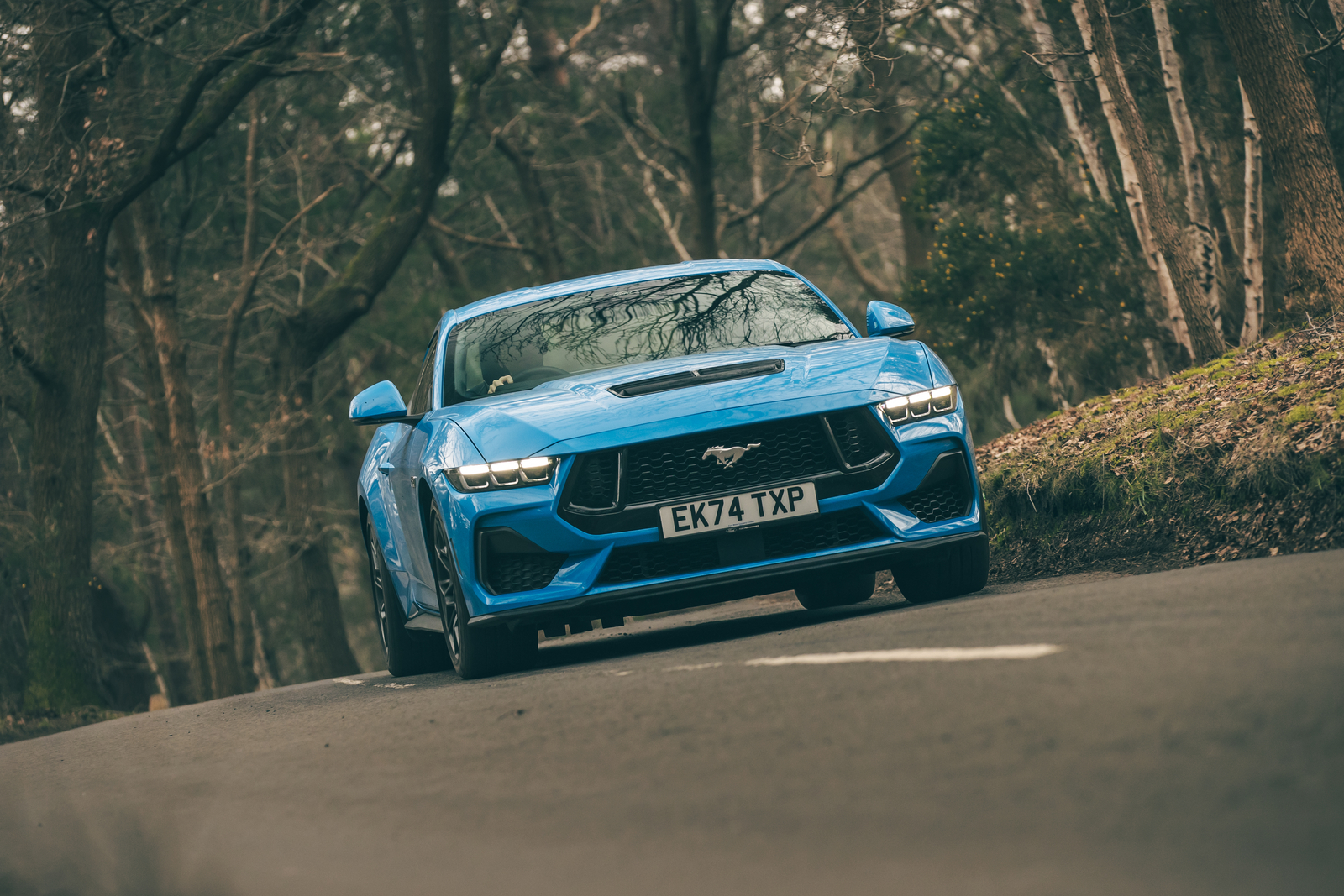
- Design8
- Interior8
- Performance9
- Ride & Handling8
- Costs8
Pros
Utterly charming
Good value
Comfortable
Cons
Looks aren’t to everyone’s taste
More sensible sports cars exist
Not exactly economical
Best for: V8 power
The Ford Mustang with a 440bhp V8 engine can still be yours for just under £56,000, and we liked it so much we named it our Best Dream Car at the annual Autocar Awards last year.
We would recommend the manual over the auto, and the standard GT is more than powerful enough and ultimately nearly £12,000 less than the Dark Horse.
That said, the Mustang ownership experience has a few drawbacks in the UK. The car’s sheer size means you have to think twice about where to park it in town and what kinds of country lanes you might seek out with it.
With its dipsomaniac 5.0-litre V8, meanwhile, you will need to factor in more frequent visits to the pumps than your peers in their German sports cars.
The Mustang is a throwback of a sports car yet few direct rivals have such obvious likability. Its powertrain brings with it an appeal that engines with fewer cylinders simply don’t muster, and its rear-drive chassis balance is pretty peachy too.
Read our Ford Mustang review
Save money on a new Ford Mustang with What Car?
Finance this car with Drivenfi
9. BMW Z4
8
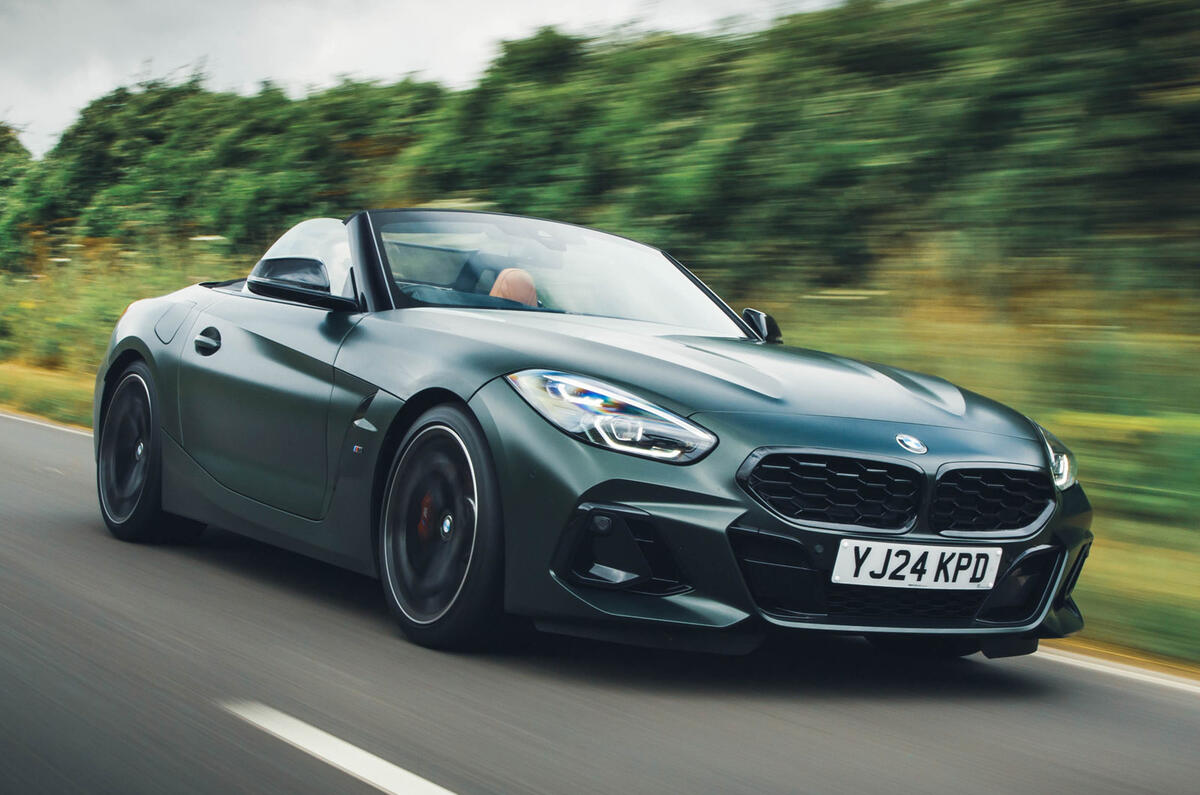
- Design8
- Interior9
- Performance10
- Ride & Handling8
- Costs8
Pros
Available with a manual gearbox
Impressive comfort
Outstanding erganomics
Cons
Not as potent as the Porsche 718 Boxster
No choice of colour with the manual
Rubbery manual shift isn’t to all tastes
Best for: Manual gearbox
The Z4 isn’t quite as hardcore as many of the other options on this list, but it’s still one of the better sports cars on sale in the UK today.
The Z4 is more of an alternative to the 718; one that is cheaper, more comfortable and works better when you just revel in that wonderful engine at a moderate pace.
The sports car, which is only available as a soft-top convertible, comes in two specifications: the entry-level sDrive20i, which uses a 2.0-litre turbocharged petrol engine, and the more powerful M40i, which uses BMW’s brilliant ‘B58’ 3.0-litre straight six.
In its most powerful specification, the Z4 pumps out 335bhp and 369lb ft, hitting 0-62mph in 4.6sec.
While an eight-speed automatic is standard, a six-speed manual was also introduced in 2024, which we thought gave the Z4’s already excellent engine even greater appeal.
Admittedly, the Z4 lacks the dynamic ability of several of its rivals, but its stable and comfortable chassis offers something different.
It’s more of a cruiser that can excel when pushed, with a stunning engine, a great manual gearbox and, of course, that drop-top thrill.




